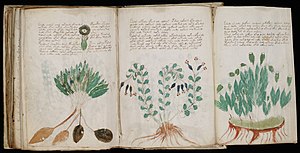
Back Vitela AN ورق الرق Arabic Вялень (матэрыял) Byelorussian Велен (пергамент) Bulgarian Leuegen Breton Vitel·la Catalan Velin Danish Vellum German Vellum English Veleno Esperanto

Vellum is a high-quality form of parchment. Originally, it meant calf skin, but in English the term is used more widely.[1]
Like parchment, the skin is prepared to take writing in ink.[2] It was one of the standard writing surfaces used in Europe before paper became available. It continued to be used for high-status documents. The vellum was used for single pages, scrolls, codices or books.
To manufacture vellum, the skin is cleaned, then bleached, stretched on a frame called a "herse", and scraped with a knife. When vellum is scraped, it is by turns wet and dry to create tension. A final finish is got by rubbing the surface with pumice, and treating it with lime or chalk. Then it is ready to accept ink.[2]
Modern "paper vellum" (sometimes called vegetable vellum) is made out of synthetic material instead of mammal skin, but is used for the same purpose as normal vellum.
- ↑ "vellum - Origin and meaning of vellum by Online Etymology Dictionary". www.etymonline.com.
- ↑ 2.0 2.1 "Differences between Parchment, Vellum and Paper". National Archives. 15 August 2016.
© MMXXIII Rich X Search. We shall prevail. All rights reserved. Rich X Search